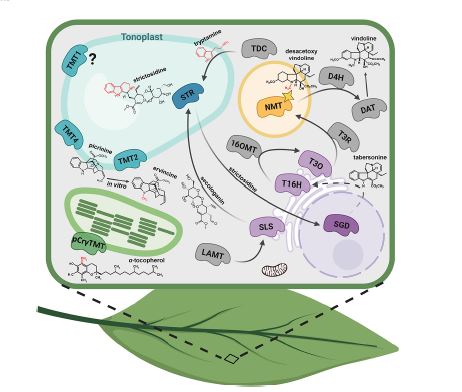Tonoplast and Peroxisome Targeting of γ-tocopherol N-methyltransferase Homologs Involved in the Synthesis of Monoterpene Indole Alkaloids
- Recherche,
A research article published in Plant and Cell Physiology in november 2021.

PCP
Authors
Konstantinos Koudounas 1 , Gregory Guirimand 1 2 , Luisa Fernanda Rojas Hoyos 3 , Ines Carqueijeiro 1 , Pamela Lemos Cruz 1 , Emily Stander 1 , Natalja Kulagina 1 , Jennifer Perrin 1 , Audrey Oudin 1 , Sébastien Besseau 1 , Arnaud Lanoue 1 , Lucia Atehortùa 4 , Benoit St-Pierre 1 , Nathalie Giglioli-Guivarc'h 1 , Nicolas Papon 5 , Sarah E O'Connor 6 , Vincent Courdavault 1
Affiliations
- 1 Biomolécules et Biotechnologies Végétales, Université de Tours, Tours EA2106, France.
- 2 Graduate School of Sciences, Technology and Innovation, Kobe University, Kobe, Japan.
- 3 Grupo de Biotransformación-Escuela de Microbiología, Universidad de Antioquia, Calle 70 No 52-21, A.A 1226, Medellín, Colombia.
- 4 Laboratorio de Biotecnología, Sede de Investigación Universitaria, Universidad de Antioquia, Medellin, Colombia.
- 5 GEIHP, SFR ICAT, University of Angers, Université de Bretagne Occidentale, Angers 49000, France.
- 6 Department of Natural Product Biosynthesis, Max Planck Institute for Chemical Ecology, Jena 07745, Germany.
Abstract
Many plant species from the Apocynaceae, Loganiaceae and Rubiaceae families evolved a specialized metabolism leading to the synthesis of a broad palette of monoterpene indole alkaloids (MIAs). These compounds are believed to constitute a cornerstone of the plant chemical arsenal but above all several MIAs display pharmacological properties that have been exploited for decades by humans to treat various diseases. It is established that MIAs are produced in planta due to complex biosynthetic pathways engaging a multitude of specialized enzymes but also a complex tissue and subcellular organization. In this context, N-methyltransferases (NMTs) represent an important family of enzymes indispensable for MIA biosynthesis but their characterization has always remained challenging. In particular, little is known about the subcellular localization of NMTs in MIA-producing plants. Here, we performed an extensive analysis on the subcellular localization of NMTs from four distinct medicinal plants but also experimentally validated that two putative NMTs from Catharanthus roseus exhibit N-methyltransferase activity. Apart from providing unprecedented data regarding the targeting of these enzymes in planta, our results point out an additional layer of complexity to the subcellular organization of the MIA biosynthetic pathway by introducing tonoplast and peroxisome as new actors of the final steps of MIA biosynthesis.
Keywords: Alkaloids; Catharanthus roseus; N-methyltransferase; Peroxisome; Subcellular localization; Tonoplast.

